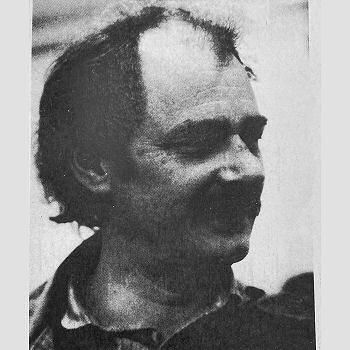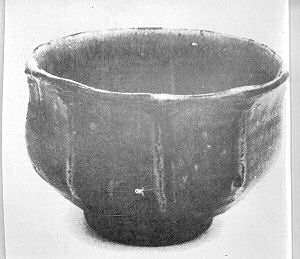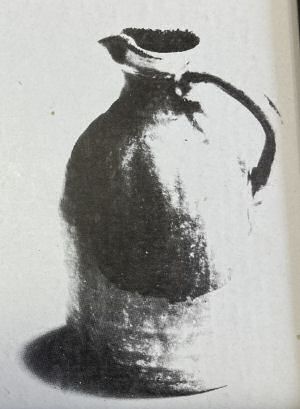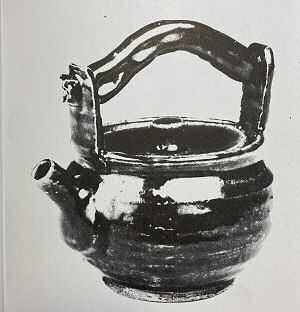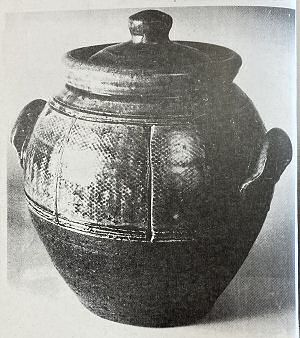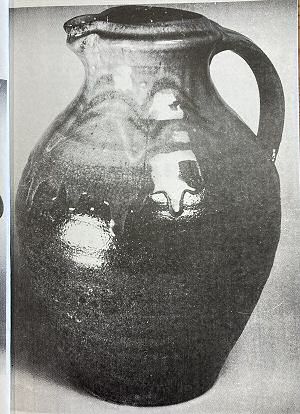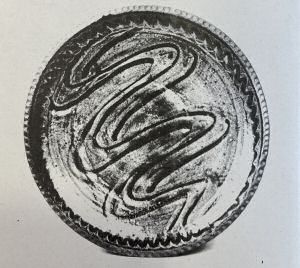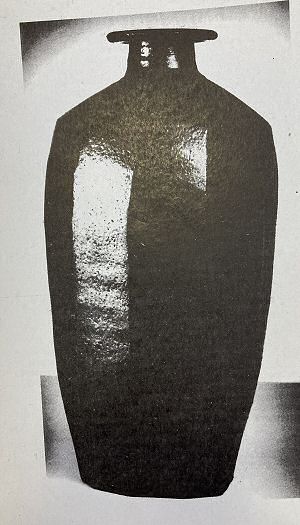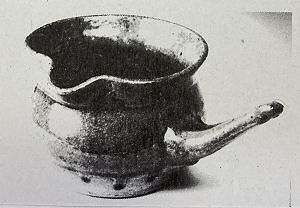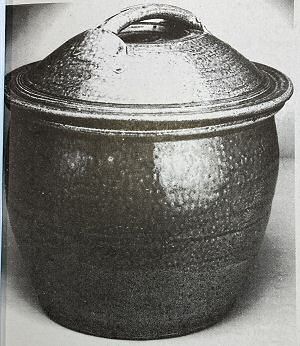By way of introduction I need to clarify that studio
pottery is but one possibility within the Higher National
Diploma in Design course run here and validated under
the new Business & Technical Education Council. There
are various other options in Textiles and Ceramics and
related areas which attempt to give a flexible approach
to imaginative students.
Whatever the combination of subjects a student
wishes to learn, the fundamental intention of the
course is to set students along the way to becoming
craftsworkers in their own right. As far as this article
is concerned I am writing specifically about the area
I am involved in, that is, Studio Pottery.
Without going into detail, vis a vis the course
structure, suffice it to say that within two short
years we cover those areas considered relevant to
workshop situations throwing, decoration, press
moulding, hand building, glaze technology (empirical
and theoretical), geology, kiln theory and kiln building
using various fuels, general workshop practice and so
on. In support of these we include business and professional studies, historical studies, drawing, pattern,
equipment making and photography. However,what I am
primarily interested in here are the less quantifiable
qualities, the feel, the texture, the essence of the educative process being attempted here.
It is not enough, in this process, to touch dryly upon
the informative aspects of, history, of culture, of technique it is not enough to know what is happening
in the crafts today. To be moved, to be inspired, to
touch one's own vitality, to quicken that is enough.
Without this, however masterful one's technique, or
one's knowledge, there is no beauty, no warmth, no
humanity. Unfortunately one cannot give students this,
one cannot teach it. It is nevertheless within each of
them to a lesser or greater degree.
This is the real dilemma and challenge of teaching.
There are no answers, only a constant learning process
by staff and students engaged in an interactive process
which hopefully inspires and informs. The working atmosphere begins to enrich, excite and deepen. Discussions
spring up, pots are talked about, subtleties noted. Clay
and its magic begins to reveal itself not as a separate
thing to be manipulated or exploited, but as material
with expressive qualities of its own which run deep in
their relationship to ourselves. If this fundamental respect
is not born then "The result is that the material
is unable to give us its love, because in the processes
to which we subjected it, we ourselves did not give it ours...."
(Michael Cardew).
Jim Malone and myself stress that good form is
the fundamental language of pottery. If we add to that
a passion for clay and the interactive transformation
through fire then we have the necessary ingredients given
a sufficient degree of talent, to aid would be potters on
their way. To draw out these qualities, to feed and nourish
them is our job and for better or worse we go about
it in a particular way.
Essentially it boils down to this, exposure. Exposure
to as many pots, both historical and contemporary which
exemplify the best in form, vitality, strength, warmth
humour, pattern and all those other human qualities which
relate to and touch upon our nature, to enrich and inform
our experience. This exposure is effected by visits
to exhibitions and collections. Last year the students
went to see those lovely pots from Buckley in North
Wales, to Bill Ismay's contemporary collection, to
Richard Batterham's superlative exhibition at the British
Crafts Centre, to "Shibui" at Gordon Reece Gallery
in Knaresborough, to name but a few by visits to
museums, e.g. the Gulbenkian in Durham and that
wonderful collection of medieval jugs locked in a
basement of the Yorkshire museum in York etc. By
films on Cardew, Leach, Isaac Button, Geoffrey Whiting,
in fact anything we can get hold of which is searching
either in philosophy technique or common sense. By
demonstration and contact with visiting lecturers, who,
although often very different in approach and talent
nevertheless enjoy, handle and use clay in an essentially
sensitive way. Last year we were fortunate to have
with us,albeit for short periods, John Maltby, Colin
Pearson, Janet Leach, Takeshi Yasuda, Richard Launder,
Mick Doherty and Shizuko and Ted Hughes. By the time
this goes to print Clive Bowen and Patrick Sargent will
have been. Over exposure? Well, so be it. Apart from
these vital "interjections" the students are expected to
work hard on technique through a variety of briefed
disciplines, build kilns, (wood and gas) test out local
materials for glazes, slips and bodies (in the second
year, bringing materials from the areas they intend to
set up their workshops), put on an exhibition with the
other participants in the Design Crafts Course, make
a piece of equipment (a wheel for example) and attend
the supporting studies and lectures mentioned earlier.
Towards the end of their first year, all students are
placed preferably with a pottery of their choice for two
or three weeks as a taster to actual workshop experience.
In the second year the students settle down to consolidate
and specialise in the way they choose to work, mixing
and/or testing their own clay bodies and glazes and shareing
or using their own kilns, whenever possible.
Watching and seeing students move through the
necessary stages of understanding is rewarding. It is
only natural that certain forms, surfaces, decorative
qualities, firing techniques excite and are explored. very
often the forms belong to a different culture and functioned
within a context that no longer exists. Initially,
for educative purposes this is of no consequence. Later
the student will have to look at the specific needs and
functional contexts within which pots and clay objects
are needed today and make choices as to the area they
most want to work in. Indeed, it is possible today, with
so many varying environments, to adapt forms to new
contexts, without qualitative concessions, which previously.
did not exist.
Since learning is an evolutionary process, not necessarily steady,
with troughs and peaks, periods of certainty
and periods of pain, one cannot in two short years expect
students to have carved out a style and a maturity in
so brief a time. Nevertheless, most students, about halfway through their second year have created an inertia
and rhythm in which the seeds of their character are
clearly discernible. Work falls into place, not just any
old place but a place from which all natural, enriching
and sustaining communication occurs, the right place
the love of it.
I like to think that perhaps we have gone some way
in allaying the fears expressed by H, Davis in his pamphlet, An Historical Review of Art, Commerce, and Industry
and I quote:-
"One looks to education for signs of hope, but
it is committed to training young people to
man the social order as it exists, and although
it pays lip service to the idea that things
should be done for the right reasons, only its
rebels seem in fact to succeed in this respect.
The truly simple and adequate reasons for making
pots disappear from view when any gimmick is
worth a try as an indication of originality,
and any publicity is worth chasing as a means
to fame. To do something in order to appear
to be original, to adopt mannerisms and play
the eccentric in order to appear to be an artist,
to pursue fame as a conscious objective are
all symptoms of sickness and examples of actions
taken for the wrong reasons. In saying that
potters should have the courage to be potters,
one is merely saying that they should have the
courage to do things for the right reasons...."
STUDENT CONTRIBUTIONS
JANIS DEVES
Before I came on the course I was
running, searching, looking for something around every
corner. Now I no longer seek out and hope for
is enough to be standing.
MARTIN TAYLOR
Today I believe the majority of
peoples lives are too 'instant', all thin and watery
like instant tomato soup. I look at myself as someone
who is going to try and rediscover the 'body' in life
and, who knows, perhaps even be fortunate enough to
put some back in to other peoples.
OLWEN ROBERTS
I now know why I have a need to
make pots, because of the sheer joy of forming
an object of use and decoration out of one of our
own earth's materials and firing it in a wood flame.
STEPHEN BARKWORTH
During the last year and a
half I could not decide what I most wanted to do.
On the one hand I loved the effect of ash glazes and
the philosophies and ideals of the Japanese and Korean
cultures, and on the other hand I felt that the
traditional pottery of this country should not be
allowed to die out. I feel a lot happier now that
I have decided on earthenware, and my pots seem to
have taken on a new boldness because of this.
I feel very priviledged to have been here - this
course has given me more than just the skills of
pottery, it has awakened in me a deep feeling for
clay. You cannot work against it, forcing it to do
things it does not want to do, you have to work with
it, coax it, love it...
STEPHEN ROBERTS
I would like to say, briefly,
a few things which are important to me in life. Richard
Batterham called such things our 'stars and landmarks'.
We all have our own very different likes, but I feel
they do contain elements which can be applied to us
all. One 'star' for me is exemplified in this quotation.
From Bob Dylan "well you pulled me out of bondage,
and made me renewed inside, filled up a hunger that
had always been denied, opened up a door no man can
shut, and you opened it so wide, and you have chosen
me to be amongst the few. What can I do for you?"
Another is beautifully put by Yanagi :
"To me the greatest thing is to live beauty
in our daily lives, and to crowd every moment
with things of beauty. It is then and then only
that the art of the people as a whole is endowed
with its richest significance. For its products
are those made by a great many people for the
mass of the people and the moment this art
declines, the life of the nation is removed
far away from beauty. So long as art abides
in only a few articles created by a few geniuses,
the kingdom of beauty is nowhere near
realisation".
I agree with Yanagi, a nation cannot be healthy if
it does not have these qualities. The only thing which
holds us back is ourselves. There are those who are
doing their excellent best, but they are unfortunately
few and far between.
